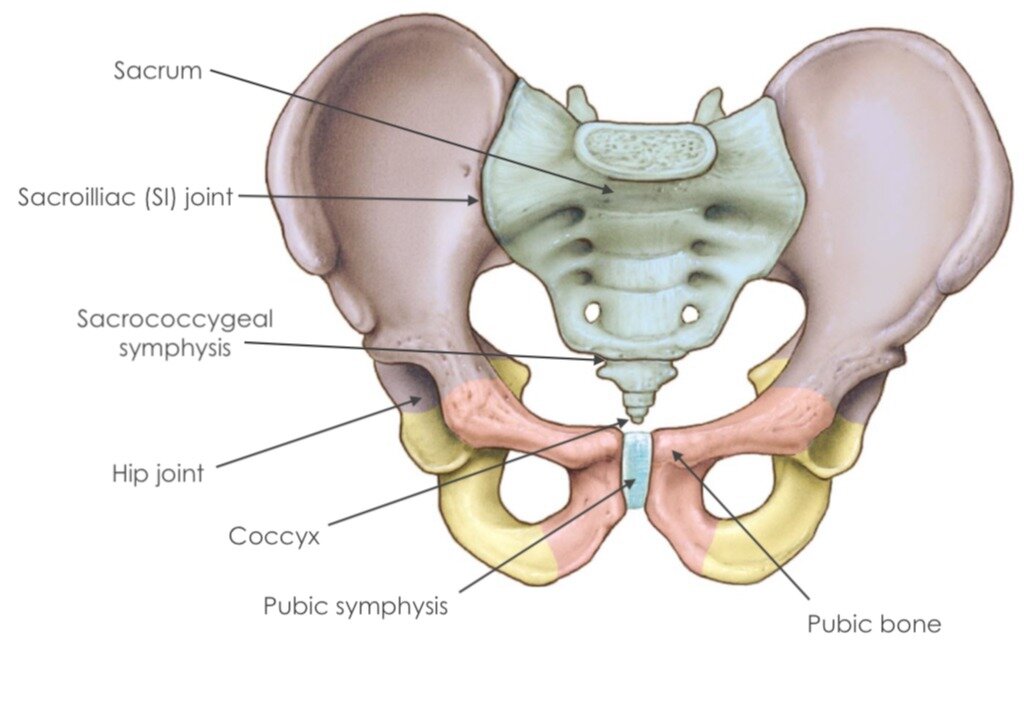Pelvic girdle what now?!
What is Pelvic Girdle Pain?
Pelvic Girdle Pain (PGP) – sometimes referred to as Symphysis Pubis Disorder – is the term used to describe the collection of uncomfortable symptoms caused by uneven movement or stiffness of your pelvic joints. PGP is pain in the front or back of the pelvis but it can also affect your hips and/or thighs.
The Pelvis.
The pelvis is a basin-shaped structure made up of the left and right hip bones, the sacrum and the coccyx. There are four points at which the bones come together: two sacroiliac joints, the sacrosoccygeal symphysis and the pubic symphysis.
Thick, strong ligaments usually hold the pelvis together making it largely immobile. However, hormonal changes during pregnancy - namely the release of relaxin - cause these ligaments to soften and loosen which in turn allow the pelvis to shift, widen and essentially prepare for birth.
PGP occurs when the joints move unevenly and surrounding muscles work hard to compensate, often resulting in tightness and tenderness. The growing weight and pressure of your baby and changes in the way you sit or stand can add additional strain on your pelvis.
SYMPTOMS OF PGP.
PGP affects around 1 in 5 women during pregnancy. It can present as mild or severe, intermittent or persistent, and can impact your day-to-day in a number of different ways including:
- Pain in the pubic region, lower back, hips, thighs or knees
- A clicking or grinding sensation in the pelvic area
- Pain made worse by certain movements, for example:
o Parting your knees, like when getting in/out of the car
o Walking on uneven surfaces, or for long periods of time
o Shifting weight onto one leg, like when walking upstairs, getting in/out of the bath or getting dressed
o Rolling over in bed
o Twisting or turning
o During sexual intercourse
TREATMENT OF PGP
In most cases once diagnosed, PGP can be treated to avoid long-term discomfort, especially if treated early which is why it is important to discuss any concerns with your midwife or medical practitioner.
PHYSIOTHERAPY
Physiotherapy is often a common means of managing pain. A physio will be able to assess your posture and work to correct it, get hands on to manipulate your pelvis encouraging it to sit and move correctly and massage soft tissue to encourage tight muscles to relax. They may also recommend specific exercises or stretches for you to do at home.
self-treating
Things you can do yourself include:
- Keeping active within your pain limits
- Being aware of your posture, standing and sitting tall with your baby and bottom tucked in slightly
- Not sitting still for long periods of time
- Using pillows or wedges when lying to support your legs, hips and/or back
- Avoiding single leg actions or exercises and any movements that you notice make pain worse
- Getting plenty of rest
OTHER OPTIONS?
Other treatment options for PGP include: acupuncture, hydrotherapy and support belts or crutches.
WILL PGP AFFECT MY BABY?
Whilst PGP can be very painful for you, rest assured that it will not harm your baby and in most cases PGP will not prevent you from being able to have a vaginal birth. If you’re suffering from PGP then it is a good idea to make sure that your delivery team are aware of your needs so that they can support your legs and help you change position or move around more easily.
WHAT HAPPENS AFTER MY PREGNANCY?
More often than not, PGP improves after birth. However, 1 in 10 women will have on-going pain. Keeping active and mobile, and continuing with your treatments until discomfort settles down is recommended.
One question I get asked often is if PGP will present itself again in the next pregnancy. My answer is that whilst it’s not a given, it is more likely. Keeping active and building strength and stability before getting pregnant again can help, as can seeking support early should symptoms present themselves again.
THE TAKEAWAY?
Know that PGP can be managed and is not a definitive sign that you should give up exercise during your pregnancy. Note that movement and exercise is recommended as a means of managing the symptoms and so gentle movement and a good antenatal trainer should be able to adapt your plan to accommodate your needs. If you are suffering the pains associated with PGP don’t feel that it’s just another pregnancy niggle. Speak with the professionals around you, get it checked out and do your homework as it could make all the difference to your pregnancy experience.

